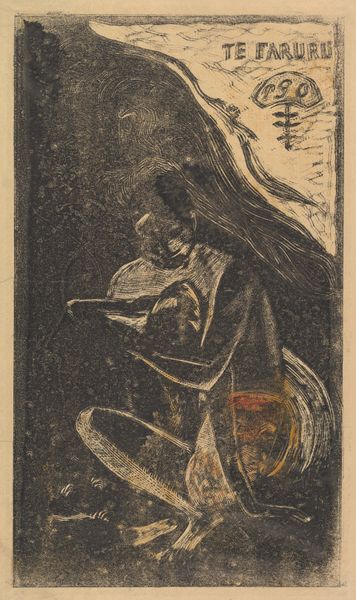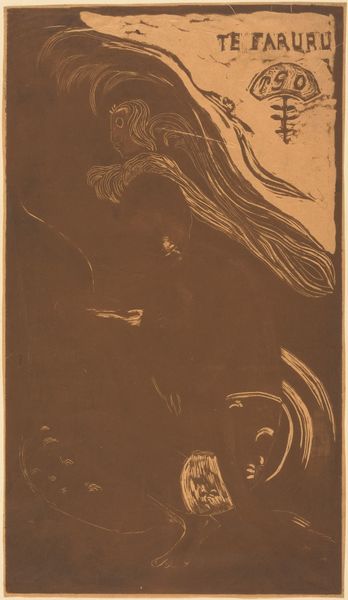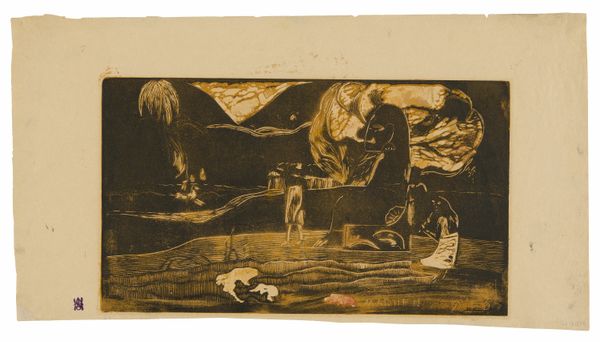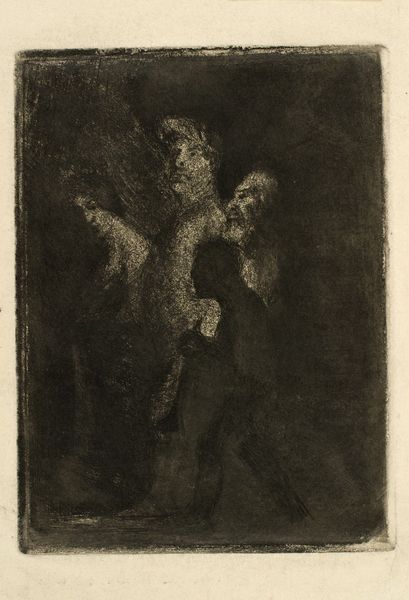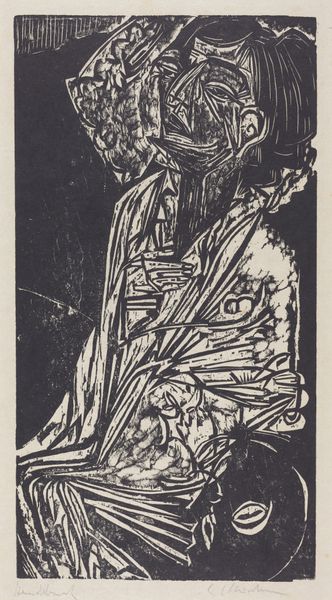
Te faruru (Here We Make Love), from the Noa Noa Suite 1893 - 1894
0:00
0:00
print, paper, woodcut
# print
#
paper
#
woodcut
#
france
#
symbolism
#
post-impressionism
#
nude
#
erotic-art
Dimensions: 356 × 202 mm (image), 359 ×206 mm (sheet)
Copyright: Public Domain
Curator: This woodcut print, "Te faruru (Here We Make Love)", was created by Paul Gauguin between 1893 and 1894, as part of his "Noa Noa" suite, reflecting his time in Tahiti. It’s currently held at The Art Institute of Chicago. What's your initial impression? Editor: There's something heavy and dreamlike about it, like a half-remembered myth pressing in on reality. The dark tones, especially, evoke a powerful mood of secrecy. Curator: Absolutely, the darkness plays a vital role. Gauguin used the woodcut medium to create stark contrasts and textures, emphasizing the raw and somewhat primitive aesthetic he associated with Polynesian culture. Look at the flowing hair and simplified figures; how do they speak to you? Editor: Well, hair, particularly long hair, is almost universally linked to power, fertility, even raw emotion. Here, it's a cascade, blurring the line between the figures and the surrounding darkness, creating a sense of being immersed in primal forces. Then there's the title itself... "Here We Make Love." It directly ties into an essential aspect of human experience. What about you, what stands out when you consider the symbols and title? Curator: The symbolism is intentionally ambiguous. The Tahitian figures are idealized, almost archetypal. The term “faruru” implies a meeting, not necessarily love in a conventional sense. The stylized "T90" emblem, I think that he tried to express indigenous Tahitian cosmological symbols. What Gauguin was aiming at with his symbolism? I feel it like some of the hidden psychological places that the western artists projected in art. Editor: Exactly! It’s this exoticist gaze blended with Gauguin's own personal and artistic journey. But it also begs questions about appropriation. It reminds me, of how throughout history, love, fertility and connection get projected onto "other" cultures, it highlights deep-seated cultural anxieties and desires. Curator: Perhaps the heart of this work, and others from "Noa Noa", is not an ethnographic record, but instead, the expression of a highly individual search. What if that image isn't truly of a Tahitian paradise, but of a kind of refuge located in Gauguin's own soul? Editor: That’s a beautiful perspective, actually, turning the whole thing inward. That maybe his journey into the soul started elsewhere. It certainly challenges us to look beyond the surface and question the nature of looking itself. Curator: It does. This image, "Te faruru", becomes both a document of a time and place, and a timeless exploration of desire, identity, and artistic fantasy. It has made me remember the need for introspection when faced with strong cultural images and symbols. Editor: And for me, a fresh look at how love, even within a single frame, has boundless possibilities to appear in myriad ways.
Comments
No comments
Be the first to comment and join the conversation on the ultimate creative platform.

